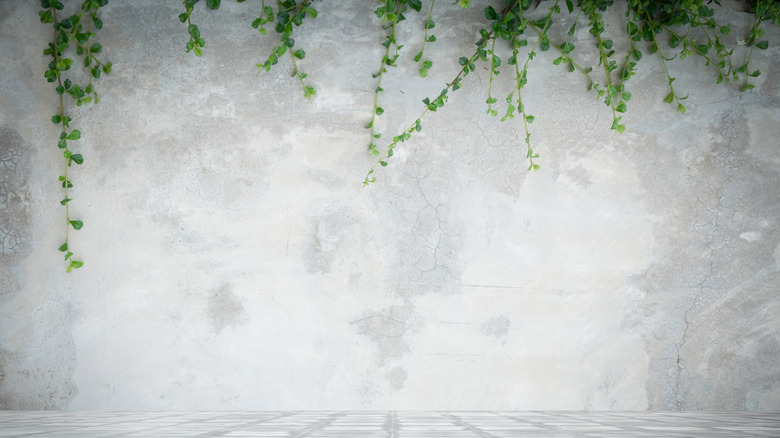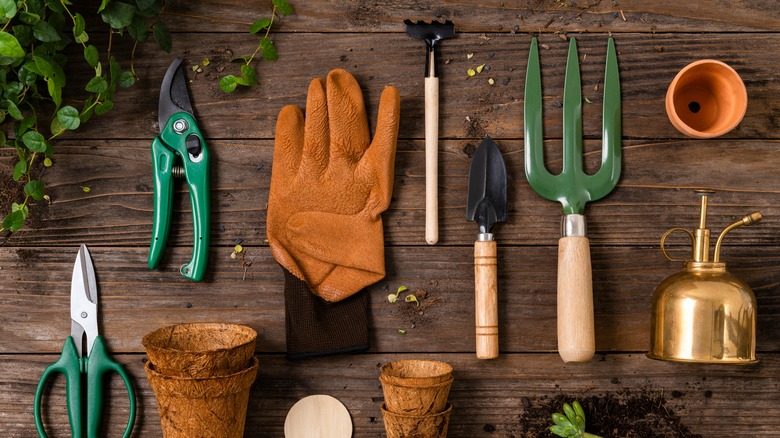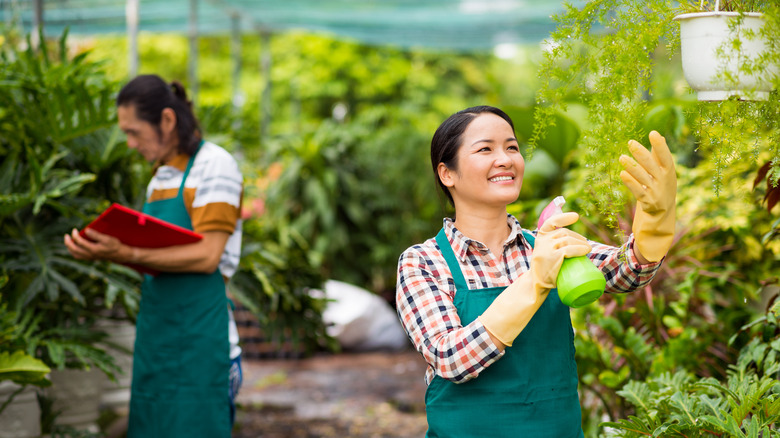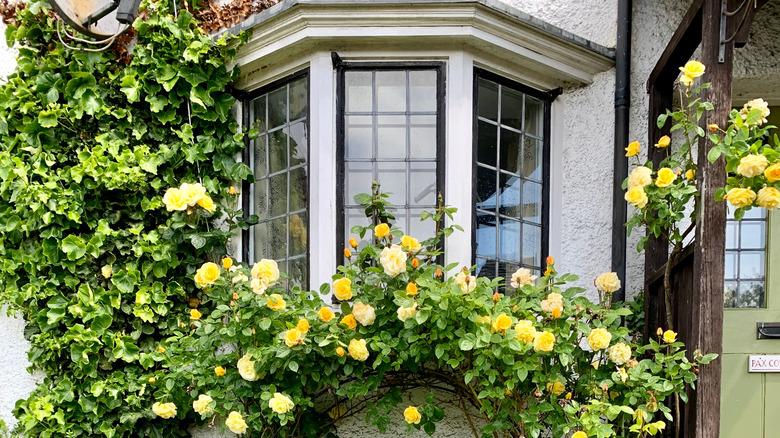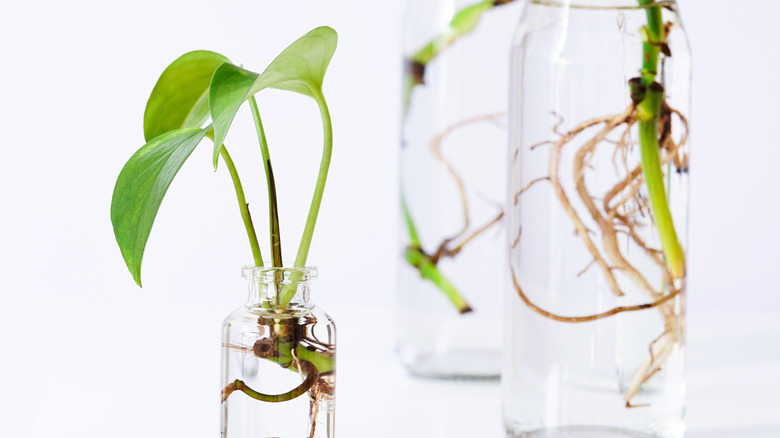How To Successfully Grow An Ivy Plant
The ivy plant (scientific name: Hedera) is a climbing evergreen known for covering prestigious colleges across the east coast. Although it has pretty foliage and is easy to grow, it is also notorious for morphing into a clingy, ruinous pest when mismanaged. According to Gardening Chores, you have fifteen species of ivy to choose from, with the most traditional variety being English ivy. Ivy offers beauty and also health benefits, says Balcony Garden Web. Indoors, it can purify your air and minimize mold. Outside, it is a modern gardener's friend for a hearty ground cover in those shady spots that need filling.
The ivy vine sprouts dark leaves that are lobed and sometimes heart-shaped, with thin, light veins and, depending on variety, outlined in yellow or white. According to BBC Earth News, the vine "climbs" by way of its aerial roots, which run a sophisticated system of emitting sticky goo to affix to a tree or wall while tiny "root hairs" snuggle into any pore, pit, or gap, which further anchors the vine. Eventually, little berries full of seeds germinate that birds love to snack on and then spread, so the whole process starts again.
Despite its invasive power, we have been investing in the care and cultivation of ivy since the times of yore. Its pedigree goes as far back as ancient Egyptian and Grecian gods who symbolized immortality and vigor, according to The Joy of Plants. The effect of ivy can be romantic and austere or invasive.
How To Use Ivy In A Garden
While ivy is generally seen outdoors, taking over buildings, it's great inside too. Consider putting your potted ivy in bedrooms or living rooms since studies show it improves air quality and has been noted for lowering your chances of coughs and colds, according to Healthline.
Ivy outside takes more planning. Try it where it's tough to grow anything else, but be strategic about how far and wide you want it to spread as a groundcover. It will give you a great solution for those damp, shady, bare areas since it spreads and foliates quickly with very little effort from you, says Leafy Place. However, once it takes hold, its knack for spreading will keep spreading and will choke out other plants that are nearby. Be ready with the pruning shears every spring and possibly one or two additional times each year to keep your ivy in check.
Ivy is also great for covering those bits of garden fences or building walls that could benefit from a beautiful drape look. Steer clear of certain varieties in this case, like the Swedish ivy, which SFGate says will fail to climb and may grow only 2 or 3 feet, compared to the more desirable English ivy that boasts heights nearing 80 feet and spread that stretches nearly 50 feet. Another terrific climber is the Boston ivy, with leaves that turn a beautiful crimson come fall, says the Spruce.
How To Grow Ivy
You want to give your ivy a chance to get started growing before the hot summer months, so SFGate encourages planting ivy in fall or early spring. Ivy likes soil that drains easily and is found in shade. Too much direct sun can make ivy leaves look burned.
Your best bet is to start with a few ivy cuttings and plant them in a hole you dig just a little wider than your ivy root base, around 8 inches deep. However, ivy can frankly start just by covering the foliage from an ivy cutting with soil, according to eHow Home. Your ivy will root and grow from even that alone, so long as you leave a little room between cuttings. Water your sprouts after you finish covering the hole with soil and water every week after that until the ivy is established. If you're planting indoor ivy, follow the same steps in a large flowerpot for several ivy cuttings or a small pot for only one ivy cutting, using potting soil for planting. Water the soil after you've planted your cuttings, then wait to water again until your topsoil is dry to the touch. Once your ivy is strong and growing, you can water it weekly.
Watch for your leaves to turn all green or lose their variegated lines. According to Gardening Know How, this can be a sign that the ivy needs to be repositioned in a brighter place in your home.
How To Care For Ivy
Water your ivy when the soil is dry to the touch almost halfway down into the pot, says House Beautiful, around once a week, though a little less often in winter months while it's dormant from its growth cycle, says GardenerReport.com. The water should flow out of your pot's drainage hole and into the saucer, which you should empty promptly, so your ivy does not experience any root rot.
While ivy does thrive outdoors in shady spots, you will want to position your indoor ivy pots where they experience a lot of light (though not direct sunlight), according to Southern Living. Indoor ivy should be pruned regularly at the stem, says bloomscape. Outdoor ivy should also be pruned regularly, up to two to three times a year, so it doesn't take over your yard or garden.
It cannot be overstated how important it is to keep track of your outdoor ivy. Unchecked, ivy can cause structural damage to buildings by shimmying between boards and can loosen mortar between bricks, according to SFGate. Even Harvard University, long known for its adorned ivy walls, has yanked some of its vines due to the nearly $50,000 annual expense to trim the ivy from vulnerable window sills, not to mention the damage they see in broken mortar bits from ivy run amok.
Ivy Varieties
The varieties of ivy (scientific name: Hedera) come from all around the world, including North Africa, Europe, Nepal, East Asia, and Macaronesia, according to PlantSnap. Although the moniker "ivy" has become a catchphrase to include all climbing plants, true ivy belongs to the Araliaceae family and has 30 species that Leafy Place says are identified by the different size, shape, and color of their leaves as well as vine growth length.
The most common variety is English ivy (scientific name: Hedera helix), which makes a beautiful drape over fences or a lush ground cover. English ivy also makes for a nice houseplant, though HappySprout says a variety of English ivy, the Glacier ivy, is particularly great as indoor ivy. It's a little easier to keep under control, and its leaves are a beautiful deep green with white edging, according to Monrovia.
According to PlantSnap, other popular ivy species include:
- Algerian ivy (Hedera algeriensis) hails from West Africa and can grow to 40 feet tall with yellowish-green blooms.
- Persian ivy (Hedera colchica "Dendroides") has dark green, heart-shaped leaves and likes a little more direct sun than other ivy plants.
- Cyprus ivy (Hedera cypria) has unlobed leaves with bright white veins and grows blackberries, unlike other ivy plants.
- Irish ivy (Hedera hibernica) has bigger leaves and has a better fragrance than English ivy.
Are Ivy Plants Toxic?
Ivy should be kept out of reach of pets because a few unnoticed nibbles of your ivy by your cat or dog can make them really sick -– from a little extra drool to full-on vomiting and diarrhea, says ABC Everyday. Also, although many ivy plants grow berries, they are not for eating. Turf Unlimited Inc warns that despite the fact that birds can safely ingest these berries, the tiny seeds inside the berries can swell your skin and tongue.
Additionally, the gooey fluid on the English ivy can cause irritation if your pet chews or swallows it or even touches it. If that happens, Wag! says to flush your pet's mouth out with cool water. Consider tempting your pet with an ice cube to lick or chew, which should help moderate any pain or swelling caused by the sap. Fortunately, English ivy is not tasty, so after a little try, pets regularly decide to steer clear of it without getting too much that would create bigger problems.
How To Repot An Ivy
If the leaves of your ivy are turning yellow or limp, or if you notice ivy roots coming through the drain holes at the bottom of your pot, Wild Interiors says it is time to repot your ivy. To begin, consider watering your ivy, so the plant slides out of the soil more easily. Choose a pot just slightly larger, around 1 to 2 inches wider than the current pot you are using for your plant. Fill with new potting soil.
Remove your plant. Pull apart the root ball of the ivy, then repot into the fresh soil. Add additional soil as needed. Firmly pack your soil, then water thoroughly, making sure you have planted your ivy, so the leaves are high enough in your pot to get light. You may consider cutting your current ivy into two or even more pieces to grow into several plants rather than simply repotting one. To do this, make sure each piece has one or two leaves, says Gardening Know How.
Plant Specific Information
It is clear that ivy is the only plant whose name is casually used to classify an entire group of prominent East Coast universities. What is less clear is how the cluster of Brown, Columbia, Cornell, Dartmouth, Harvard, Penn, Princeton, and Yale Universities all came to have the signature tag "Ivy League."
One theory, according to CollegeRaptor, is that Harvard, Princeton, Columbia, and Yale constituted the first sports league, which was represented by the Roman numeral for four. Written, that looks like IV League. However, a more common story stems from the ivy on the academic buildings. Considering the universities were some of the earliest established in America, it is no surprise they followed suit with the European flair of ivy-covered buildings. According to Best Colleges, historically, students would ceremonially plant ivy on Class Day. To that end, a sportswriter from the 1940s, when writing about these ivy-covered schools, used the term Ivy League in his editorial. According to CollegeRaptor, that is the origin story that most historians endorse.

